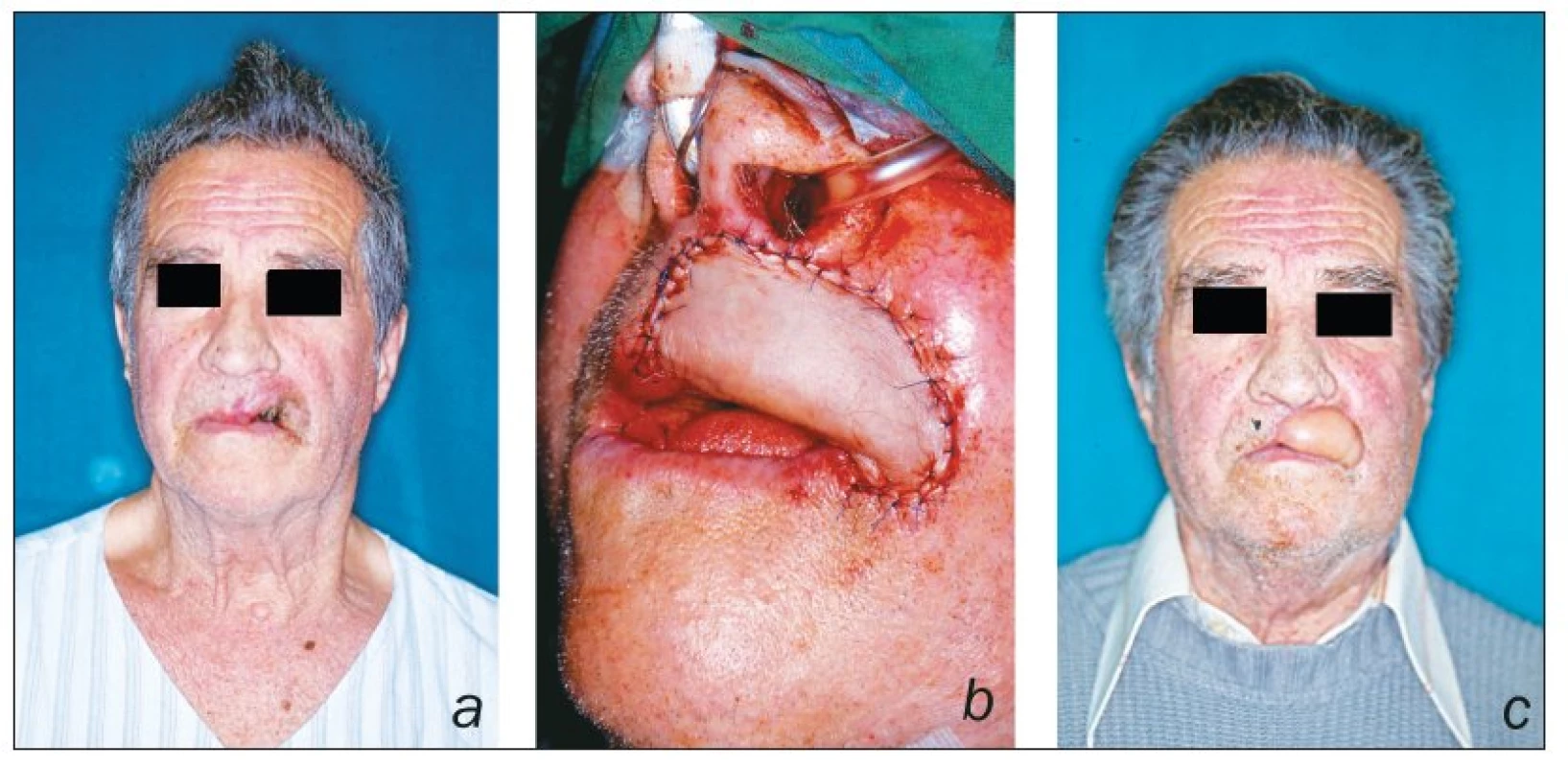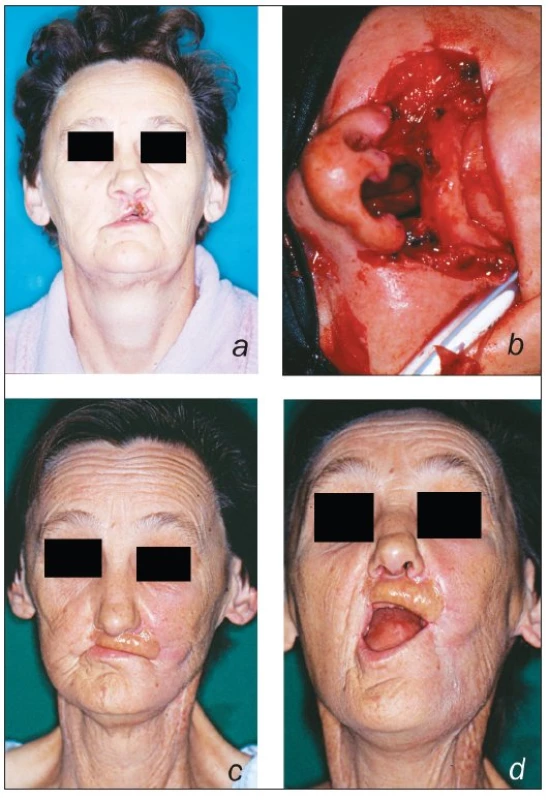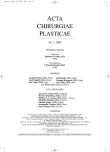RECONSTRUCTION OF LARGE UPPER LIP DEFECTS BY FREE TISSUE TRANSFER
Autoři:
K. Bozikov 1; Z. M. Arnez 1,2
Působiště autorů:
Department of Plastic Surgery, University Medical Centre Ljubljana, Slovenia, and
1; UCO Chirurgia Plastica e Ricostruttiva, Ospedale di Cattinara, Trieste, Italy
2
Vyšlo v časopise:
ACTA CHIRURGIAE PLASTICAE, 50, 2, 2008, pp. 51-53
INTRODUCTION
From aesthetical point of view lips are one of the most exposed and prominent parts of the face. Their function is to provide oral competence and help in deglutition and articulation. They define each person’s appearance and help in making a person individually recognizable.
Lip reconstruction, however, remains difficult, especially when trying to achieve not only good function but also a pleasant aesthetic appearance. Ideally, the lip defect should be replaced with “like tissue” using local flaps from adjacent lip remnants and cheek. However, when the loss of tissue is a subtotal or total upper lip, such a reconstruction inevitably produces microstomia (5), which is unacceptable for patients using dentures.
We present our experience with reconstruction of near total or total upper lip defects by using free tissue transfer.
PATIENTS AND METHODS
From 1996 to 2006 seven patients, five men and two women, aged between 52 and 88 years, required subtotal or total upper lip reconstruction. Four patients had locally advanced squamous cell carcinomas, two basal cell carcinomas and one sarcoma of the upper lip. Radial forearm free flap was used for reconstruction in six patients. One upper lip was reconstructed with free anterolateral thigh flap. One patient had local recurrence of the disease one year after resection of tumour and radial forearm free flap reconstruction. Radical resection of tumour recurrence with the flap used for reconstruction was performed and the resulting defect of the upper lip was reconstructed by another radial forearm flap.
Operative technique
For reconstruction of near total or total upper lip defect a radial forearm or anterolateral thigh free flap were selected, depending on availability of donor site, thickness of subcutaneous fat and colour match. The preferred donor site had a better colour match to facial skin, and less subcutaneous fat. After harvesting, the flap was folded on itself, the inner leaf replacing loss of mucosal lining and the outer leaf replacing skin deficit. Insetting started at the mucosal site and proceeded towards the outer site. Flap’s vessels were tunnelled in subcutaneous plane into the neck, where they were anastomosed with recipient vessels in end-to-end fashion. The flaps were not sensate and we did not use any fascia sling or muscle to reconstruct the missing orbicularis oris muscle. To reconstruct vermilion tattooing was offered as a second stage procedure.
The mean follow up time of the patients was 43 months (range, 4 to 68 months).
Sensory testing
Four out of seven patients underwent sensory testing of the reconstructed upper lip with a minimum time of 16 months after surgery. In all four cases reconstruction was performed using the radial forearm free flap. Six sensory modalities – touch pressure sensitivity, superficial (prick) pain, hot and cold temperature discrimination, and static and dynamic two point discrimination – were examined at centre of the skin paddle. Touch pressure sensitivity was measured using Semmes Weinstein standardized mono-filaments, superficial pain was evaluated by pricking the flap with a needle, hot and cold discrimination was tested with the cotton end of a cotton-tipped applicator that had been dipped in ice cold or heated water, two point discrimination was tested with two-point discriminator plastic disc.
RESULTS
All eight flaps survived and primary healing took place in all patients. No secondary procedures were performed. No fistula formation or sialocele were observed. In assessment of functional result, oral competence, deglutition and articulation were main consideration. All patients achieved oral competence in rest and during eating and speaking and were able to use their dentures after reconstruction. Deglutition and articulation were not affected in any patient.
Three out of four patients who underwent sensory testing of reconstructed upper lip showed some recovery of sensation. One patient detected monofilament 4.31, which is equivalent of 2 gram force and is considered as diminished protective sensation. Two-point discrimination was present in two flaps and none of the patients regained cold or hot discrimination in the area of flap (Table 1).

Case report No. 1
A 78 year-old man presented with large basal cell carcinoma of the upper lip (T2N0M0). Excision of the tumour produced a through and through defect of two thirds of upper lip including left oral commissure. Reconstruction was performed with folded radial forearm flap. The patient had satisfactory appearance and a competent oral aperture and refused additional secondary procedures as debulking of the flap or vermilion tattooing (Fig. 1).

Case report No. 2
A 62 year-old lady presented with a T2N1M0 squamous cell carcinoma of the upper lip. Excision of tumour resulted in near total upper lip defect. Simultaneously bilateral modified radical neck dissection was performed. Reconstruction was accomplished using folded radial forearm free flap. The patient had superb function with good sensory recovery except for discrimination of hot and cold (Fig. 2).

DISCUSSION
Large full thickness defects of the upper lip can be successfully reconstructed with a variety of local flaps (1, 9). Local tissue provides better texture and colour match and thus increases the final aesthetic result. However when soft tissue defect presents as near total or total upper lip or it is even extending beyond the anterior part of the maxilla, reconstruction with local tissue inevitably produces microstomia (5).
Such defects require reconstruction flaps consisting of thin and pliable tissue. From many free flaps used for such reconstructions, we used free radial forearm or free anterolateral thigh flaps. Both match the requirements for reconstruction of large lip defects (3, 4, 7, 10-12). Furuta et al. (4) incorporated the palmaris longus tendon in the radial forearm flap and Yildirim et al. (12) used composite anterolateral thigh-fascia lata flap to reinforce the new lip and achieve oral competence. We believe, when the lip defect does not involve the lower lip, the flap for reconstruction can be purely fasciocutaneous, and fascia lata, palmaris longus tendon or even muscle incorporated in it is not necessary. All our patients presented use dentures and one of our goals was to reconstruct a mouth wide enough for use of denture also after surgery.
Sensory re-innervation in a transferred flap occurs through two patterns of nerve fibre regrowth: peripheral ingrowth from surrounding nerves and when nerve anastomosis is performed, through surgically created nerve pathways. Different studies confirmed that innervated flaps demonstrated better sensory recovery than the non-innervated flaps (2, 6, 8). However debate remains, whether demonstrated differences produce functional advantage. Kimata et al. (6) compared sensory recovery in innervated and non innervated anterolateral free flaps for oral reconstruction. Despite his innervated flaps reached statistically significant better sensory recovery, Semmes-Weinstein testing revealed that none of two groups of flaps reached level of protective sensation. Even more, a gingival ulcer developed without pain in one of his patients in whom Semmes-Weinstein testing had suggested good sensory recovery. In another study Netcher et al. (8) concluded that innervated flaps for oral reconstruction do not appear to offer major functional advantage over the non innervated flap. On the other hand there are reports in the literature about excellent sensory recovery of innervated flaps for lip reconstruction (3). Our patients regained moderate sensory recovery. Modalities, as protective sensibility and hot and cold differentiation, which would offer functional benefit, were not reached though.
We believe that subtotal or total upper lip reconstruction with folded thin fasciocutaneous free flaps produce very good functional and aesthetically acceptable results and avoid additional scars on lower lip. The size of the mouth is not altered, which is especially important for patients using dentures.
Address for correspondence:
Kresimir Bozikov, M.D.
Department of Plastic Surgery
University Medical Centre Ljubljana
Zaloska 7
1000 Ljubljana
Slovenia
E-mail: kresimirbozikov@yahoo.com
Zdroje
1. Behmand, RA., Rees, RS. Reconstructive lip surgery. In Achauer, BM., Eriksson, E., Guyuron, B., Colemann III, JJ., Russell, RC., Vander Kolk, CA. (Eds) Plastic Surgery. St. Louis: Mosby Inc., 2000, p. 1193-1209.
2. Boyd, B., Mulholland, S., Gullane, P., Irish, J., Kelly, L., Rotstein, L., Brown, D. Reinnervated lateral antebrachial cutaneous neurosome flaps in oral reconstruction: are we making sense? Plast. Reconstr. Surg., 93, 1994, p. 1350-1359.
3. Eguchi, T., Nakatsuka, T., Mori, Y., Takato, T. Total reconstruction of the upper lip after resection of a malignant melanoma. Scand. J. Plast. Reconstr. Surg. Hand. Surg., 39, 2005, p. 45-47.
4. Furuta, S., Sakaguchi, Y., Iwasawa, M., Kurita, H., Minemura, T. Reconstruction of the lips, oral commissure, and full-thickness cheek with a composite radial forearm palmaris longus free flap. Ann. Plast. Surg., 33, 1994, p. 544-547.
5. Karapandzic, M. Reconstruction of lip defects by local arterial flaps. Br. J. Plast. Surg., 27, 1974, p. 93-97.
6. Kimata, Y., Uchiyama, K., Ebihara, S., Kishimoto, S., Asai, M., Saikawa, M., Ohyama, W., Haneda, T., Hayashi, R., Onitsuka, T., Nakatsuka. T., Harii, K. Comparison of innervated and non-innervated free flaps in oral reconstruction. Plast. Reconstr. Surg., 104, 1999, p. 1307-1313.
7. Mandrekas, AD., Page, R., O’Neill, TJ. Upper lip reconstruction with a radial forearm free flap. J. Craniofac. Surg., 5, 1994, p. 105-107.
8. Netscher, D., Armenta, AH., Meade, RA., Alford, EL. Sensory recovery of innervated and non-innervated radial forearm free flaps: functional implications. J. Reconstr. Microsurg., 16, 2000, p. 179-185.
9. Sarifakioglu, N., Aslan, G., Terzloglu, A., Ates, L. New technique of one-stage reconstruction of a large full-thickness defect in the upper lip: bilateral reverse composite nasolabial flap. Ann. Plast. Surg., 49, 2002, p. 207-210.
10. Takada, K., Sugata, T., Yoshiga, K., Miyamoto, Y. Total upper lip reconstruction using a free radial forearm flap incorporating the brachioradialis muscle: report of a case. J. Oral. Maxillofac. Surg., 45, 1987, p. 959-962.
11. Wei, FC., Tan, BK., Chen, IH., Hau, SP., Liau, CT. Mimicking lip features in free-flap reconstruction of lip defects. Br. J. Plast. Surg., 54, 2001, p. 8-11.
12. Yildirim, S., Gideroglu, K., Aydogdu, E., Avci, G., Akan, M., Aköz, T. Composite anterolateral thigh-fascia lata flap: a good alternative to radial forearm-palmaris longus flap for total lower lip reconstruction. Plast. Reconstr. Surg., 117, 2006, p. 2033-2041.
Štítky
Chirurgie plastická Ortopedie Popáleninová medicína TraumatologieČlánek vyšel v časopise
Acta chirurgiae plasticae

2008 Číslo 2
- Metamizol jako analgetikum první volby: kdy, pro koho, jak a proč?
- Primární prevence osteoporózy v kostce
- Neodolpasse je bezpečný přípravek v krátkodobé léčbě bolesti
- Léčba akutní pooperační bolesti z pohledu ortopeda
Nejčtenější v tomto čísle
- ARTERIALIZED VENOUS FREE FLAPS – A RECONSTRUCTIVE ALTERNATIVE FOR LARGE DORSAL DIGITAL DEFECTS
- GIANT CELL REPARATIVE GRANULOMA IN THE MANDIBLE – CASE REPORT AND REVIEW OF THE LITERATURE
- RECONSTRUCTION OF LARGE UPPER LIP DEFECTS BY FREE TISSUE TRANSFER
- THE VALUE OF CLINICAL DIAGNOSIS OF DIGITAL GLOMUS TUMORS
